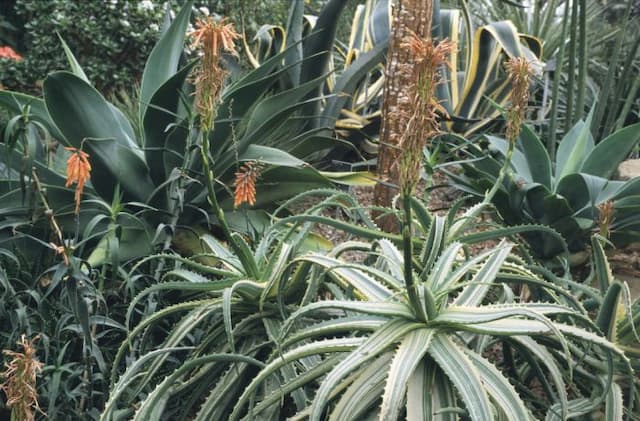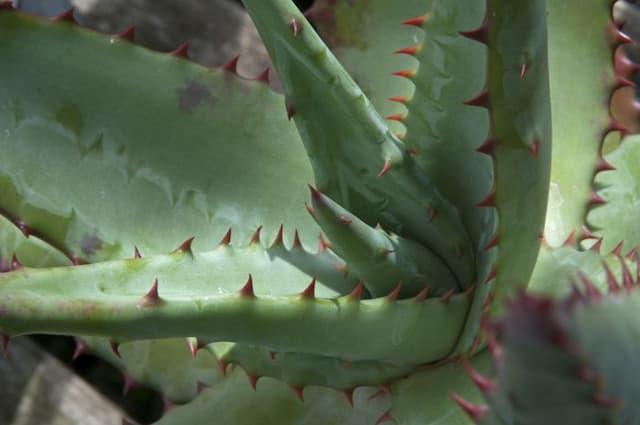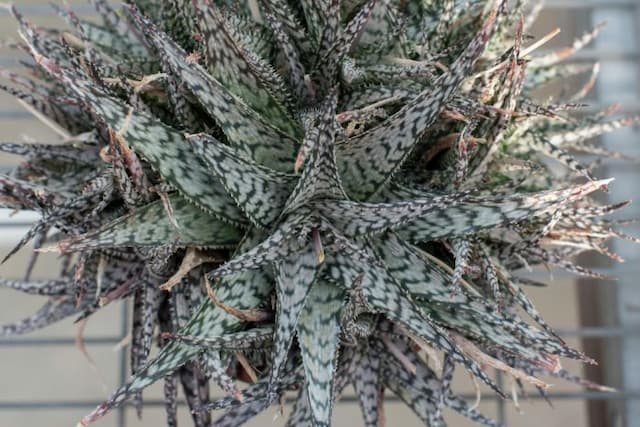Red Hot Poker Kniphofia 'Jonathan'

ABOUT
The plant known as Kniphofia 'Jonathan' is commonly referred to as Red Hot Poker due to its distinctive, fiery-coloured flower spikes. This perennial plant features a rosette of long, slender, and arching green leaves, which form a grassy clump at the base. The leaves are often sword-like in shape, adding a structural element to the foliage. Rising above the foliage, the most striking feature of Kniphofia 'Jonathan' is its bold floral display. The flowers are arranged on tall, sturdy spikes that tower over the leaves below. Blooming from the bottom up, the tubular flowers showcase a gradient of colour, typically ranging from a rich, warm yellow at the bottom to a vibrant, glowing red or orange at the top, resembling a torch or a flame. This warm spectrum of colors makes it a vivid addition to gardens. The flowering period of Kniphofia 'Jonathan' usually occurs in the summer, attracting butterflies, hummingbirds, and other pollinators to the garden. After the flowers have finished blooming, the spikes remain, eventually turning to a tawny color, which can provide visual interest even when the plant is not in peak bloom. Overall, the Red Hot Poker is celebrated for its dramatic flowers that serve as focal points in gardens, providing a dash of color that stands out against the greenery of its own foliage and other plants.
About this plant
 Names
NamesFamily
Asphodelaceae.
Synonyms
Red Hot Poker, Torch Lily, Tritoma.
Common names
Kniphofia 'Jonathan'.
 Toxicity
ToxicityTo humans
Red hot poker, including the variety 'Jonathan', is not commonly listed as toxic to humans. However, as with any plant, individual allergies or sensitivities could provoke a reaction in some people. Consumption of plants that are not intended for ingestion could potentially cause stomach upset or discomfort.
To pets
Red hot poker is also not widely known to be toxic to pets. Still, it is always advisable to prevent pets from eating ornamental plants, as they could cause gastrointestinal upset or an allergic reaction in rare cases. If a pet were to ingest a large amount of the plant, it would be best to consult with a veterinarian.
 Characteristics
CharacteristicsLife cycle
Perennials
Foliage type
Evergreen
Color of leaves
Green
Flower color
Mixed
Height
2-3 feet (0.6-0.9 meters)
Spread
1-2 feet (0.3-0.6 meters)
Plant type
Herb
Hardiness zones
5-9
Native area
South Africa
Benefits
 General Benefits
General Benefits- Aesthetic Appeal: Adds vibrant color to gardens with its striking red to yellow flower spikes.
- Attracts Pollinators: Draws in bees, butterflies, and hummingbirds, which are essential for pollination.
- Drought Tolerant: Once established, it is capable of withstanding periods of low rainfall.
- Low Maintenance: Requires minimal care beyond occasional watering and deadheading.
- Perennial Growth: Comes back year after year, providing long-term garden interest.
- Deer Resistant: Typically not preferred by deer, which can help protect other garden plants.
- Seasonal Interest: Blooms in the summer, adding seasonal variation to the garden.
- Suitable for Cut Flowers: The blooms can be used in floral arrangements, adding natural beauty indoors.
- Versatile Planting: Can be planted in borders, beds, and containers, offering flexibility in garden design.
- Soil Adaptability: Tolerates a range of soil types, from clay to loamy soils.
 Medical Properties
Medical PropertiesThis plant is not used for medical purposes.
 Air-purifying Qualities
Air-purifying QualitiesThis plant is not specifically known for air purifying qualities.
 Other Uses
Other Uses- The stiff, fibrous leaves of Kniphofia, commonly known as Red Hot Poker, can be used in creating small handcrafted items such as bookmarks or decorative wristbands.
- Due to their unique flower shape, Red Hot Poker blooms can be incorporated into floral art, such as Ikebana, the Japanese art of flower arranging.
- The dried seed pods of Red Hot Poker can be used as rattles or added to musical instruments for a percussive effect.
- When cultivated on a larger scale, Red Hot Poker can serve as a natural privacy screen or living fence due to its height and foliage density.
- The tall, robust nature of Red Hot Poker makes it suitable for use in windbreaks in home gardens or small farms.
- Red Hot Poker can be used in educational settings such as schools or botanical gardens to teach about pollination, as it attracts hummingbirds and bees.
- For hobbyists in model making or dioramas, parts of the Red Hot Poker plant, like the flower spikes, can be used to replicate natural scenery.
- The nectar-rich flowers can be used in a sustainable garden to produce homemade syrups, although it's not a common practice and should only be done with safe knowledge of plant properties.
- Since Red Hot Poker plants are resistant to deer and other grazing animals, they can be included in gardens to help deter wildlife from more sensitive plants.
- In areas with proper climatic conditions, Red Hot Poker can be grown as a long-living perennial, reducing the need for seasonal replanting and thus serving as an eco-friendly landscaping option.
Interesting Facts
 Feng Shui
Feng ShuiThe Red Hot Poker is not used in Feng Shui practice.
 Zodiac Sign Compitability
Zodiac Sign CompitabilityThe Red Hot Poker is not used in astrology practice.
 Plant Symbolism
Plant Symbolism- Hot Emotions: Often referred to as "Red Hot Poker" due to its fiery-colored flowers, this plant symbolizes intense emotions and passion.
- Standing Out: With its striking flowers, the Red Hot Poker symbolizes being noticed and standing out from the crowd.
- Attractiveness: The vibrant flowers can also represent attractiveness and allure, catching the eye of onlookers and pollinators alike.
- Boldness: The plant's bold looks embody courage and the bravery to be oneself.
- Warmth: The warm colors of the Red Hot Poker signify coziness and comfort, much like a warm hearth.
 Water
WaterThe Red Hot Poker plant requires consistent moisture, particularly during the summer months, but it's important to avoid overwatering. Water deeply to establish a strong root system, providing 1 to 2 inches of water per week, depending on rainfall and soil conditions. During hot or dry spells, increase watering to twice a week, ensuring at least 1 gallon of water per plant. Cut back on watering as the plant goes dormant in the winter, and water only if the soil is very dry. Always water at the base of the plant to keep the foliage dry and prevent fungal diseases.
 Light
LightThe Red Hot Poker plant thrives in full sun conditions, demanding at least 6 to 8 hours of direct sunlight daily for optimal health and blooming. The plant can tolerate partial shade, but flowering may be reduced. Choose a spot in the garden that receives unobstructed sun for most of the day to ensure the plant's vigorous growth and vibrant flower spikes.
 Temperature
TemperatureThe Red Hot Poker plant can tolerate a wide range of temperatures but grows best when the daytime temperature is between 60 to 75 degrees Fahrenheit. It can survive temperatures as low as 30 degrees Fahrenheit, making it suitable for growing in USDA zones 5 through 9. The plant can withstand high temperatures well, but it requires adequate moisture to cope with the heat.
 Pruning
PruningPruning Red Hot Poker plants helps to maintain their shape, remove spent flower spikes and encourage additional blooming. After the flowers fade, cut the flower stalks back to the base of the plant. During the early spring or late fall, remove any dead or damaged foliage to keep the plant tidy and healthy. Pruning is typically needed once after blooming and occasionally for foliage maintenance.
 Cleaning
CleaningAs needed
 Soil
SoilRed hot poker thrives in well-draining, rich soil with a pH range of 6.0 to 7.0. A blend of loamy soil, compost, and coarse sand is ideal to provide the necessary nutrients and drainage.
 Repotting
RepottingRed hot poker is typically not repotted frequently as it is a perennial plant that prefers to be left undisturbed. Division or repotting is done every 3-5 years to prevent overcrowding.
 Humidity & Misting
Humidity & MistingRed hot poker prefers moderate humidity levels but is quite adaptable and can tolerate the humidity levels typical of most outdoor environments.
 Suitable locations
Suitable locationsIndoor
Place in bright light, well-draining soil, water sparingly.
Outdoor
Full sun, well-draining soil, space plants 18 inches apart.
Hardiness zone
6-9 USDA
 Life cycle
Life cycleThe Red Hot Poker 'Jonathan' starts its life as a seed, which germinates in warm, moist soil in a well-draining location. Upon sprouting, it develops a rosette of narrow, arching leaves, during which time it establishes a strong root system. In its juvenile stage, the plant continues to put out foliage and begins to mature, which can take several years. Once mature, typically in the second or third year, it produces tall, striking flower spikes in shades of red, orange, or yellow during the late spring to early summer. After flowering, seed capsules develop which can self-sow or be collected for propagation. The plant is perennial, meaning it will die back in the winter to return from its rootstock the following spring, repeating its flower production in subsequent years.
 Propogation
PropogationPropogation time
Early Spring
Kniphofia 'Jonathan', also commonly known as Red Hot Poker or Torch Lily, is best propagated through division. This should typically be done in the spring before the plant has begun its active growth phase. To propagate by division, carefully dig up the clump of the plant ensuring to keep the root ball intact as much as possible. With a sharp and clean knife or spade, slice through the center of the clump to create new sections, each with several growth points and ample roots. These sections can then be immediately replanted in the garden at the same depth they were growing before and watered in well. Ensure each new plant has about a foot (approximately 30 centimeters) of space around it to grow. This method is not only straightforward but it also helps rejuvenate and invigorate older plants that are starting to decline in the center.









